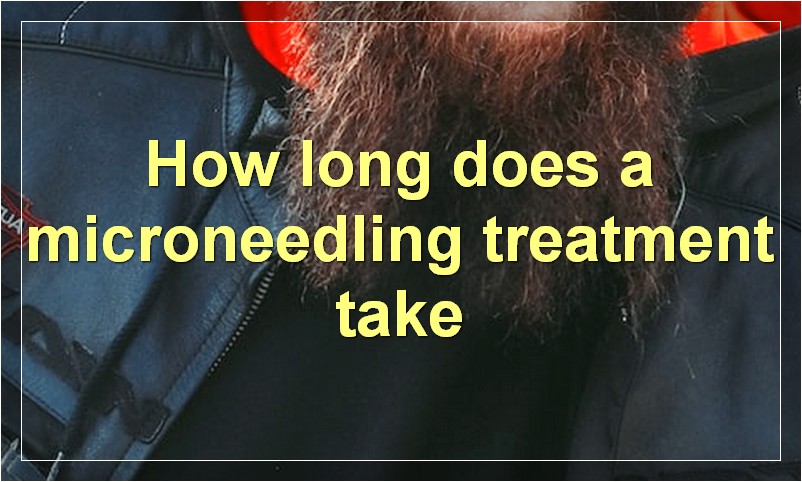If you’re looking for a way to improve your skin without resorting to harsh chemicals or surgery, microneedling may be for you. This relatively new cosmetic procedure involves using fine needles to create tiny punctures in the skin, which triggers the body’s natural healing process. Microneedling can improve the appearance of wrinkles, scars, and other skin concerns.
What is microneedling
Microneedling is a minimally invasive cosmetic procedure that involves using fine needles to create tiny punctures in the skin. This triggers the body’s natural healing response, which results in the production of new collagen and elastin. The result is firmer, smoother, and younger-looking skin.
Microneedling can be used to improve the appearance of fine lines, wrinkles, acne scars, and stretch marks. It can be performed on the face, neck, chest, and hands. The procedure is typically done in a series of treatments spaced 4-6 weeks apart.
The most common side effects of microneedling are temporary redness, swelling, and bruising. more serious side effects are rare but can include infection and scarring.
Microneedling is considered a safe and effective way to improve the appearance of your skin. If you’re considering this procedure, be sure to consult with a board-certified dermatologist or plastic surgeon who has experience performing microneedling.
What are the benefits of microneedling for men
Microneedling, also known as collagen induction therapy, is a minimally invasive cosmetic procedure that involves the use of fine needles to create microscopic punctures in the skin. This process stimulates the body’s natural production of collagen and elastin, which can help to reduce the appearance of wrinkles, fine lines, and scars.
Microneedling is often used to improve the appearance of the skin on the face, but it can also be used to treat other areas of the body, such as the chest, neck, and hands. While the procedure is generally safe and effective, there are some risks involved. These include bleeding, bruising, swelling, and infection.
Microneedling is most commonly used to treat the following conditions:
Wrinkles
Fine lines
Scars (including acne scars)
Stretch marks
Hyperpigmentation
Uneven skin texture
While microneedling is often thought of as a treatment for women, it can be beneficial for men as well. In fact, men tend to have thicker skin than women, which can make them more resistant to the effects of aging. Additionally, men are more likely to suffer from certain skin conditions, such as acne scars and stretch marks. As such, microneedling can be an effective way to improve the appearance of these conditions.
How does microneedling work
Microneedling is a minimally invasive cosmetic procedure that is used to improve the appearance of the skin. It involves the use of fine needles to create tiny punctures in the skin, which can help to stimulate collagen production and reduce the appearance of scars, fine lines, and wrinkles. Microneedling can be done using a manual device or an electronic device, and is typically performed by a dermatologist or other skincare professional.
What are the side effects of microneedling
Microneedling is a minimally-invasive cosmetic procedure that is used to treat skin concerns such as wrinkles, fine lines, acne scars, and hyperpigmentation. The procedure involves using a device that has fine needles to create tiny punctures in the top layer of skin. This triggers the skin’s natural healing process, which results in the production of new collagen and elastin fibers. Microneedling can be done at home with a derma roller or at a dermatologist’s office with a microneedling pen.
Side effects of microneedling are typically mild and include redness, swelling, and bruising. These side effects usually resolve within a few days. More serious side effects are rare but can include infection, scarring, and changes in skin color. If you experience any side effects, stop the procedure and consult your dermatologist.
Is microneedling painful
Microneedling is a minimally invasive cosmetic procedure that involves repeatedly puncturing the skin with tiny needles. The purpose of microneedling is to promote skin healing and stimulate collagen production.
Microneedling can be used to improve the appearance of fine lines, wrinkles, acne scars, and stretch marks. It can also be used to tighten loose or sagging skin.
Microneedling is usually performed using a device that contains dozens of small needles. The needles are quickly inserted into the skin and then withdrawn. This process is repeated over the entire treatment area.
Microneedling is generally well tolerated and only causes mild discomfort. However, some people may experience temporary redness, swelling, and bruising after the procedure.
If you’re considering microneedling, it’s important to consult with a board-certified dermatologist or plastic surgeon who has experience with this procedure.
How long does a microneedling treatment take
Microneedling is a popular cosmetic treatment that can be used to improve the appearance of the skin. The treatment involves using a device that has fine needles to create tiny punctures in the skin. This can help to stimulate collagen production and can improve the appearance of wrinkles, fine lines, and scars.
Microneedling treatments can vary in length, but most treatments will take between 30 minutes and 1 hour to complete. The number of needles used during the treatment will also vary depending on the areas being treated and the desired results.
After the treatment, it is common for the skin to feel slightly irritated and sensitive. This is typically temporary and will resolve within a few days. There is no downtime associated with microneedling, which means that you can resume your normal activities immediately after the treatment.
If you are considering microneedling, it is important to consult with a board-certified dermatologist or plastic surgeon who has experience with this procedure. They can help you to determine if microneedling is right for you and can develop a treatment plan that meets your individual needs.
How often should you get a microneedling treatment
A microneedling treatment is a cosmetic procedure that involves puncturing the skin with fine needles to promote collagen production. It is often used to improve the appearance of acne scars, fine lines, and wrinkles.
The frequency of microneedling treatments depends on the individual’s goals and the condition of their skin. For example, someone with mild acne scars may only need a few treatments, while someone with more severe scarring may need up to 12 treatments.
Most people see the best results after 3-6 treatments. However, touch-up treatments may be needed every few months to maintain results.
If you’re considering microneedling, it’s important to consult with a board certified dermatologist or plastic surgeon who has experience with the procedure. They will be able to assess your skin and determine how many treatments you will need to achieve your desired results.
How much does microneedling cost
Microneedling is a cosmetic procedure that involves repeatedly puncturing the skin with tiny needles in order to promote collagen production. It can be used to improve the appearance of wrinkles, fine lines, scars, and other skin concerns.
Microneedling costs will vary depending on the size of the treatment area, the number of sessions required, and the geographical location. In general, a single session of microneedling can cost anywhere from $100 to $500.
Where can I get a microneedling treatment
Welcome to the exciting world of microneedling! This minimally invasive cosmetic procedure has been gaining popularity in recent years, as more and more people discover its many benefits.
So, what exactly is microneedling? The treatment involves using a device with fine needles to create tiny punctures in the skin. This triggers the body’s natural healing response, resulting in the production of new collagen and elastin.
Microneedling can be used to improve a variety of skin concerns, including fine lines and wrinkles, acne scars, pigmentation issues, and more. It can also be combined with other treatments, such as platelet-rich plasma (PRP) therapy, to further enhance results.
If you’re interested in trying microneedling, the first step is to find a reputable provider. You can ask your friends or family for recommendations, or search online for reviews. Once you’ve found a few potential providers, schedule a consultation so that you can learn more about the treatment and see if it’s right for you.
Who should not get a microneedling treatment
If you’re not quite sure what microneedling is, it’s a treatment that uses fine needles to prick the skin and stimulate collagen production. It’s often used to improve the appearance of acne scars, fine lines, and wrinkles.
While microneedling can be helpful for some people, there are certain individuals who should avoid the treatment. Here are four types of people who should steer clear of microneedling:
1. People with active acne: If you have active acne, microneedling can actually make your breakouts worse. That’s because the needles can spread bacteria and cause inflammation. If you’re looking for a way to treat your acne, try a different method such as topical retinoids or light therapy.
2. People with open wounds: If you have any open wounds on your face, it’s best to avoid microneedling. That’s because the needles can introduce bacteria into the wound and cause an infection. Wait until your wounds have healed before scheduling a treatment.
3. People with sensitive skin: If you have sensitive skin, you may be more likely to experience side effects from microneedling such as redness, irritation, and bruising. If you’re not sure how your skin will react to the treatment, it’s best to err on the side of caution and avoid it altogether.
4. People with certain medical conditions: There are some medical conditions that contraindicate microneedling, including diabetes, keloid scarring, and blood disorders. If you have one of these conditions, be sure to talk to your doctor before scheduling a treatment.
Table of Contents






